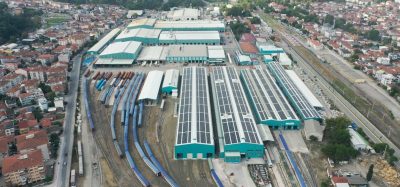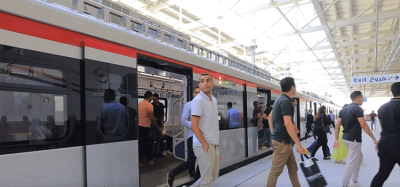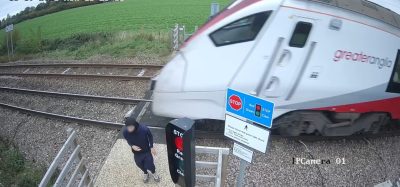PEIT: a bet on the future
Posted: 28 July 2006 | | No comments yet
On 15 July 2005, the Spanish Government approved the Infrastructure and Transport Strategic Plan 2005-2020 (PEIT). Infrastructure is considered the indispensable support for citizens to have quality transport services, and also an efficient instrument to foster economic development as well as social and territorial cohesion. The PEIT predicts a total investment cost amounting to €250,000 million, which implies an annual average of €15,500 million, and an average investing effort of approximately 1.5% of the GDP as long as the period lasts.
On 15 July 2005, the Spanish Government approved the Infrastructure and Transport Strategic Plan 2005-2020 (PEIT). Infrastructure is considered the indispensable support for citizens to have quality transport services, and also an efficient instrument to foster economic development as well as social and territorial cohesion. The PEIT predicts a total investment cost amounting to €250,000 million, which implies an annual average of €15,500 million, and an average investing effort of approximately 1.5% of the GDP as long as the period lasts.
On 15 July 2005, the Spanish Government approved the Infrastructure and Transport Strategic Plan 2005-2020 (PEIT). Infrastructure is considered the indispensable support for citizens to have quality transport services, and also an efficient instrument to foster economic development as well as social and territorial cohesion.
The PEIT predicts a total investment cost amounting to €250,000 million, which implies an annual average of €15,500 million, and an average investing effort of approximately 1.5% of the GDP as long as the period lasts.
After deep analysis, it can be said that this plan presents global aims to be translated into action guidelines for general application and for each sector in particular, thus setting out priorities and areas of action for each of them. The PEIT leads to the establishment of a mid-term and long-term rational and efficient framework for the transport system. The PEIT’s general aims are laid out in four areas:
Join our free webinar: Rail cyber-security in a time of technological and regulatory transformation
Join our expert panel, including speakers from Nokia and Siemens Mobility, to explore the critical convergence of cybersecurity and 5G rail comms.
Date: 3 Dec | Time: 15:00 GMT
Can’t attend live? No worries – register to receive the recording post-event.
- Improving the system’s efficiency
- Strengthening social and territorial cohesion
- Contributing to the system’s overall sustainability
- Encouraging economic development and competitiveness
Railway related guidelines
PEIT makes a strong bet on the railway system, establishing the following guidelines:
- Encouraging the central role of railway within the passenger and cargo transport intermodal system in the axes and corridors with the highest transport demand
- Consolidating the new railway model, inspired in the E.U railway reform, as part of the policy supporting railway improvement. The new model involves separating infrastructure management and services, creating a licensing system for railway companies, granting new railway operators access to national and international transport, strengthening railway management and creating a regulatory agency for the sector’s activity. One of the main aspects of the new model was the creation of the Railway Infrastructure Agency (ADIF), a state-owned company conceived in the Railway Sector Law passed on 1 January 2005, as the direct consequence of the decision to separate infrastructure management from transport service providers
- Setting up a high-quality service network, in compliance with the E.U. Directive 96/48/CE on the interoperability of the trans-European high-speed railway system. The network will be designed for mixed transport, including trans-European railway links. In some routes with special requirements, and due to reasons of volume and features of traffic demand, the new infrastructures will be devoted to passenger traffic exclusively
- Defining a strategy for adapting gauge tracks in the conventional network, which currently holds the broad gauge, 1.668-metre, used in the Spanish Peninsula. This strategy must be consistent with the development of the railway network and the aim of ensuring interoperability with the trans-European network. This means that it must not only pay attention to the gauge track but also to the interoperability of the remaining equipment, facilities and technology exploitation systems
The strong bet on the railway can also be perceived in the investing efforts devoted to railway transport, which adds to approximately €109,000 million (leaving out works on urban settlements). This means 43.7% of the overall investment expected for PEIT.
Regarding actions in urban settlements, a €2,400 million investment is expected to integrate the railway into the urban areas and €10,050 million in railway commuter services (including rolling stock).
A high-speed network design
As part of the Railway System, the (PEIT) includes the following policies:
- High-quality-service corridors
- Interoperability of the conventional network
- Safety and maintenance (level crossings and other actions)
- Railway environmental integration
- Railway services and operators
High-quality-service corridors must be understood as an integrated design, operation and service of the main railway transport infrastructures. It may be stated that setting up this network is the main objective of this Plan, since 70% of the railway-oriented investment is devoted to it, which equals a third of the foreseen global investment.
PEIT’s high-quality service railway network is made up of high-speed lines, which have double track, standard gauge and, in general, can channel passenger and cargo traffic, although some lines are assumed to be exclusively for passengers (some of the high-quality railway network can remain with Spanish gauge track for the time being).
Three situations are included in the high-quality- service corridors:
- New major lines and sections for exclusive use of passenger services
- Lines and sections that will be largely modified with regard to the existing line, for mixed traffic (passengers and cargo)
- Linking sections, with much less traffic than previous cases, for mixed traffic
The first case mainly deals with sections or lines that exceed a specific traffic threshold when in the operation start, thus assuring the highest social profitability and the largest impact on the territorial structure, with the biggest time saving to the serviced destinations.
The second case corresponds to medium-sized traffic lines, major line extensions, structuring cross axes and trans-European links, which will be designed firstly for mixed traffic, since the potential traffic in the serviced corridors does not seem to allow for exclusive passenger use now.
The third case includes sections or lines, usually end-section lines, with less passenger traffic and some cargo traffic.
ADIF-encouraged actions
Actions defined within the scope of the PEIT are mainly promoted by the Ministry of Development but, especially, through the Railway Infrastructure Agency (ADIF). The ADIF mission includes:
- Managing railway traffic
- Managing infrastructures
- Collecting concession fees
- Building infrastructures as requested by the Government
Therefore, ADIF is in charge of building those new infrastructures requested by the Government as well as providing maintenance for proper use of the whole railway network, both conventional and high-speed.
Less than 20 years have passed since Spain started constructing its new high-speed network and decided to build it in compliance with the UIC gauge standard. Ever since, the following lines have come into service:
- Madrid-Sevilla: 470km (in 1992)
- Madrid-Lleida: 481km (in 2003)
- Zaragoza-Huesca connection: 80km (in 2003)
In total, this adds up to over 1,000km of railway lines.
ADIF’s commitment to the development of the Spanish high-quality network has been shown in 2006 through the launch of two new sections:
- Connection to Toledo: 20km
- Lleida by-pass, 13km, and Puigverd gauge changing facility
The former, which is part of the Madrid-Sevilla line, has allowed the journey between Madrid and Toledo to be 30 minutes. The latter allows the reduction of the travelling time between Madrid and Barcelona by approximately 30 minutes with the use of new 120 series trains, which change gauge without needing to change the locomotive.
Moreover, ADIF is now facing construction of new sections:
- Córdoba-Málaga, which is joined to the Madrid-Córdoba-Sevilla line
- Lleida-Barcelona-French border, extending the existing line from Madrid
- Madrid-Valladolid, a trunk line common to all railways linking Madrid with the North of Spain
- Madrid-Valencia-Alicante-Murcia, which in turn connects these Mediterranean cities with the high-speed Valencia-Barcelona line (today still in broad gauge)
- Pajares pass, in the Valladolid-León-Asturias line
- Ourense-Santiago, which is part of the Madrid-Galicia line
- And, shortly, works will start in the Vitoria-Bilbao-San Sebastian line
All in all, only counting these lines, ADIF is carrying out 1,789km of high-quality railway lines, involving an investment of approximately €31,000 million. Other lines are still under analysis or in the project phase, including:
- Connection between Murcia and Almería
- Link to Granada, connecting in Antequera the main line Madrid-Málaga
- Madrid-Extremadura line, which will extend to Lisbon
- Connection between Valladolid and Vitoria, which will connect Madrid with these cities in the Basque country and the French Atlantic border.
The following lines are scheduled for being operational in the short term (535km):
- Lleida-Barcelona: 191km
- Córdoba-Málaga: 155km
- Madrid-Valladolid: 189km
The following axis are expected to operate in late 2006:
- Lleida-Tarragona: 70km, which will save 30 minutes between Madrid and Barcelona,
- Córdoba-Antequera: 100km, which will save 20-25 minutes between Madrid and Málaga
Integration of new UIC lines into conventional network
Gradual setting up of high-speed standard gauge corridors all across Spanish territory will yield immediate results in the connectivity possibilities of the serviced settlements, and will also allow the extension of these benefits to wider areas through the conventional network.
The peculiarity of Spain’s railway infrastructure, due to the different gauge tracks, makes it especially important to plan these processes adequately not only in terms of infrastructures, but also (and mainly) of rolling stock, since technological innovation in this area is continuously strengthening the possibilities of action, consequently affecting service quality and saving travel time. New UIC standard gauge lines do not then become ‘isolated entities’ but interwoven in the existing railway network.
This has been so since the launch of the first high-speed line in Spain running between Madrid, Córdoba and Sevilla. Gauge changing facilities were set up in Córdoba (connections with Málaga and Algeciras) and in Sevilla (with Cádiz and Huelva), which, together with the launch of TALGO trains with variable gauge axle, led to a considerable reduction in travel times (two hours between Madrid and Málaga).
New gauge changing facilities were installed in 2003, when the Madrid-Zaragoza-Lleida section was opened, which is part of the second high-speed line: Madrid-Barcelona-French border. The changer in Lleida reduces travel time between Madrid and Barcelona by three hours, and the one near Zaragoza, makes it possible to use the new line to channel traffic connecting Madrid with Logroño and Pamplona.
New self-propelled trains with variable gauge axle (series 120) have been recently included to strengthen this effect, since replacing the locomotive in movement by the gauge changer is not necessary.
This strategy will be applied as new infrastructures will be put into service. For instance, due to the forthcoming launch of the Córdoba-Antequera section, the new line will have gauge changing facilities installed in this town, which will help to reduce travel times to Málaga and Algeciras even more. Moreover, the Madrid-Granada connection will stop using the conventional line to run at high speed up to Antequera, saving over two hours in the journey.
The most significant milestone will occur when the Madrid-Valladolid line opens. Running across the Guadarrama range, it will cut the current 2.5 hours to a 1 hour journey. Like other high-speed lines, gauge changers will be set up in Valladolid, thus reducing travel times between Madrid and the big towns of the Cantabrian Coast and Galicia.
Therefore, the proper planning of infrastructure actions and new variable gauge rolling stock guarantees optimal social and territorial investment benefits.
Nevertheless, it is worth highlighting that this division between standard gauge and Spanish gauge is changing, since the PEIT foments the restructuring of the railway network by encouraging the progressive spread of the standard gauge.
Actions and technical scope
Investment on execution: latest allocations
High-speed lines require strong investment as it was shown by aforementioned provisions made by the PEIT and, more specifically, by the on-going works. For instance, investment in the construction of those high-speed lines amounted to 2,842 million euros in 2005 and is expected to exceed that in 2006.
Line cost differs, depending mainly on platform execution, especially due to the difficulties that the ground frequently imposes and the hard task of inserting the stations into the layout of the towns. If some (rather, few) cases – like the Toledo section that has just been finished – took up less than €11 million per kilometre, this figure is expected to double for the works in the Basque country.
Technical singularities: tunnels and viaducts
Finally, it is worth mentioning that high-quality railway infrastructures are not flexible at all, with in-plant radii of approximately 7,000m and slopes between 15 and 35 thousandth – whether it is mixed traffic or passenger-only traffic – together with the uneven orography of the Spanish Peninsula. So it is necessary to carry out works of unique characteristics, some of which reached international relevance due to their dimensions, technical complexity or both factors together.
In the lines running on more uneven grounds, like the Basque country, over 70% of the alignments are tunnels or viaducts. The major high-speed railway axis in Spain demands a large number of underground works to cross mountain ranges. The high number of tunnels and their considerable length makes the problems harder to face at project and construction stages. The most relevant ones are the Guadarrama tunnel (28km) on the Madrid-Valladolid line and the Pajares tunnel (25km) in the León-Asturias line.
The Guadarrama twin base tunnels cross the Central system, with top overburden of 1,000m, drilled in granite and gneisses. The drilling works ended in June 2005 and they were carried out with four double-shielded TBMs, working at an average of 18m per day.
The Pajares tunnel, also a twin project, runs across the Cantabrian Mountains and is the largest of a total of 13 tunnels under construction within a 50km section. These tunnels are currently under construction with five TBMs helped with two intermediate attacks. The site geology is complex and the geotechnical problems numerous: extremely changing, mostly poor quality ground with overburdens of 1,000m, a lot of water, methane gas, etc.
There are many other tunnels that have been recently built or are currently in project or construction phases. Some of them have been built with TBMs, such as Abdalajís (7km) twin tunnels near Málaga, and many others, usually shorter, built following conventional procedures. For instance, in the 82km separating Ourense from Santiago de Compostela, 26 tunnels are needed, culminating a total length of 21km.
As for the viaducts, the Peninsula’s orography, the water courses and the numerous existing transport infrastructures require the construction of a large number of them, of different heights, lengths and openings between pillars. In the 481km between Madrid and Lleida, 87 viaducts over 50 metres long have been built. Only between Ourense and Santiago 35 viaducts are ready for construction, with a total length of 20km, a fourth of the overall line development.
The typology and construction system are directly conditioned by the geometry of the valley which it crosses, their accessibility and the geotechnical features of the grounds on which they sit. Experience has led the people involved in the project to certain types of solutions: for example, there has been a clear increase in hyperstatic types in the most recently built lines. Although steel has been used, concrete-based solutions are more frequent, in a wide variety of building procedures.
Sometimes it is necessary to cross large valleys, which forces the construction of very singular viaducts. Some are longer than 1,000m and have pillars higher than 100m.
As to the peculiarity of their decks, we can highlight prestressed-concrete viaduct over River Ebro in Zaragoza for their light Vierendell-beam section, and the viaduct of Arroyo de Las Piedras, on the Córdoba-Málaga line, with mixed steel-concrete sections.
If we talk about pillars, we should mention the Vinaixa viaduct, in the Madrid-Barcelona line, with two steel arch columns, which goes over a skewed conventional line, and the Valle viaduct, at the North of Madrid, executed with self-moving flasework, due to its concrete central arch, which serves as fixed support.
Stay Connected with Global Railway Review — Subscribe for Free!
Get exclusive access to the latest rail industry insights from Global Railway Review — all tailored to your interests.
✅ Expert-Led Webinars – Gain insights from global industry leaders
✅ Weekly News & Reports – Rail project updates, thought leadership, and exclusive interviews
✅ Partner Innovations – Discover cutting-edge rail technologies
✅ Print/Digital Magazine – Enjoy two in-depth issues per year, packed with expert content
Choose the updates that matter most to you. Sign up now to stay informed, inspired, and connected — all for free!
Thank you for being part of our community. Let’s keep shaping the future of rail together!
Issue
Related topics
Related organisations
International Union of Railways (UIC), Spanish Railway Infrastructure Administrator (ADIF)







